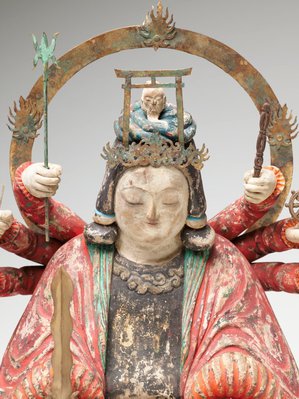
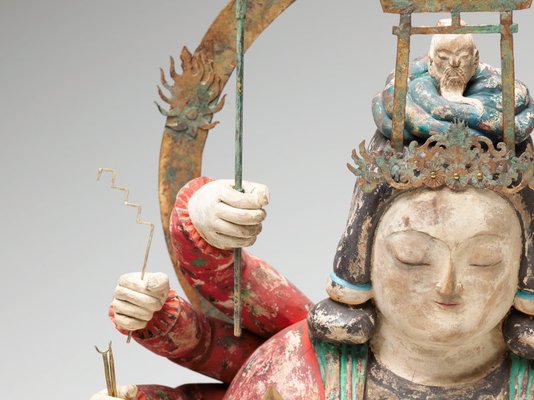
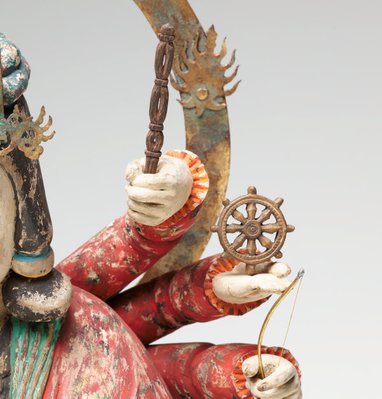
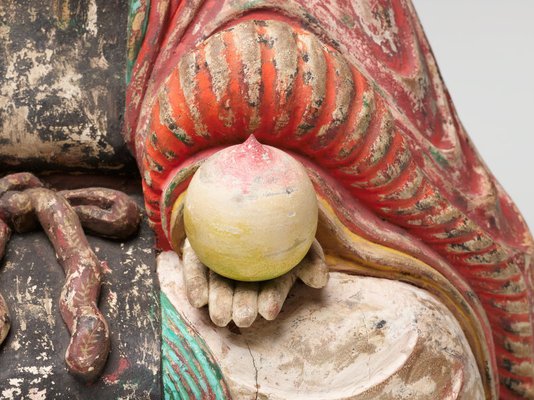
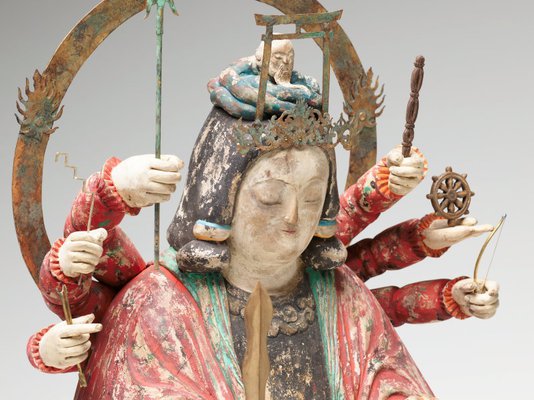
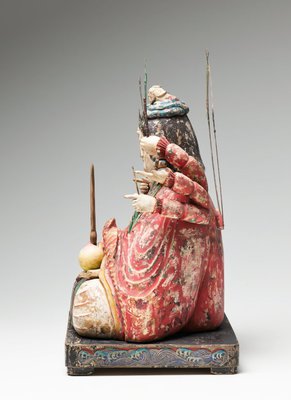
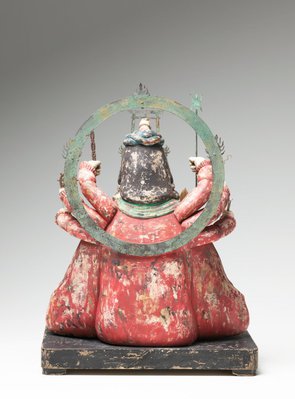
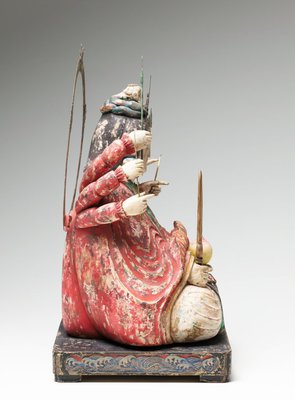
-
Details
- Place where the work was made
-
Japan
- Cultural origin
- Japan
- Date
- 2023
- Media category
- Sculpture
- Materials used
- pigments, copper plate, gold leaf and mixed media on camphor wood
- Dimensions
-
52.0 x 39.0 x 28.0 cm overall
:
a - Part a, 47 x 37.5 x 26 cm, figure
b - Part b, 5 x 39 x 28 cm, base
- Credit
- Purchased with funds provided by Andrew and Hiroko Gwinnett 2023
- Location
- South Building, lower level 1, Asian Lantern galleries
- Accession number
- 165.2023.a-e
- Copyright
- © Hideki Maekawa
- Artist information
-
Hideki Maekawa
Works in the collection
- Share
-
-
About
Hideki Maekawa (b1967 Awaji Island, Japan) trained as an oil painter and began making sculpture around 2006, primarily using found timber felled in rural areas. Inspired by discussions with artist Takashi Murakami, Maekawa’s recent focus has been creating sculptures associated with Buddhist and Shinto practice using traditional Japanese construction techniques.
This sculpture represents the goddess Uga Benzaiten, whose iconography combines the eight-armed Buddhist form of Benzaiten with a headdress comprising a Shinto shrine gate (torii) and an image of the auspicious human-faced snake deity Ugajin. The goddess holds weapons and attributes of good fortune: a treasure stick, the key to a treasure house, a bow and arrows, a sword, a trident, the Wheel of Law, and a bright jewel for granting wishes. Her halo features three flaming jewels, symbols of the eternal light of the Buddha’s teachings, and she sits atop a carved base painted with waves.
Benzaiten (also Benten) originated in India as Sarasvati, the Hindu goddess of learning and the arts. A personification of the sacred Sarasvati (now Sarsuti) River, Saravati is mentioned in the Rigveda, an ancient sacred Hindu text of the second century BCE. The deity was introduced to Japan through China between the sixth and eighth centuries and was soon welcomed into Japan’s ancient animist belief system, Shinto, ‘the way of the gods’. It was during the late eleventh or early twelfth century, that Benzaiten was conflated with Ugajin (also Uga no Mitama) who is similarly associated with water, rice, good fortune and wealth, to become Uga Benzaiten.
Depictions of Benzaiten accompanied by her fifteen attendants carrying offerings were popular in Japan’s Muromachi period (1392–1573). The Art Gallery’s collection includes a scroll painting of the goddess that was created in the fifteenth or sixteenth century. It shows Uga Benzaiten alongside other deities including Bishamonten, the guardian deity of the north who is associated with fortune in war, and Daikokuten, the god of agriculture and commerce. Bishamonten, whose origins are also in Hinduism, Daikokuten and Benzaiten are all among Japan’s popular Seven Lucky Gods, of which Benzaiten is the only consistently female deity.
The syncretic development of many deities in Japan is particularly complex and intriguing. In Maekawa’s words, ‘Japanese Buddhist statues are foreign deities brought to the small island nation from countries across the sea … As the momentum of art production spread from Nara and Kyoto to other provinces, Buddhist sculptures were repeatedly mixed with old rain and soil … at last becoming an endemic species of Japan’.
-
Places
Where the work was made
Japan
-
Exhibition history
Shown in 1 exhibition
Elemental, Art Gallery of New South Wales, Sydney, 30 Jul 2022–2024
-
Provenance
Hideki Maekawa, Jun 2023, Japan, purchased by the Art Gallery of New South Wales, Sydney, through Kaikai Kiki Gallery (art dealership), Tokyo, June 2023.
